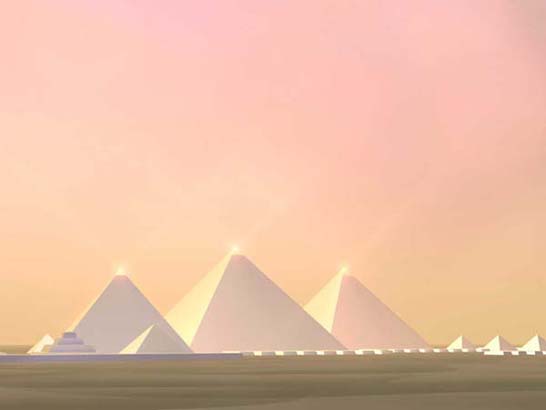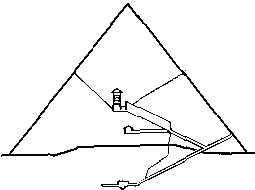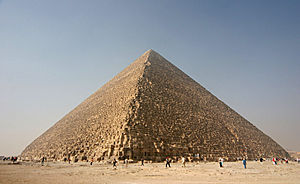Introduction
The pyramids of Giza are masterpiece architectural setups that were constructed many years ago in Egypt. The pyramids hold immense historical and cultural significance to most individuals as they give a clear picture of ancient activities and construction styles. The architectural setups that are also known as pyramids of Khufu were constructed in a large area. One of the pyramids remains the largest and oldest compared to other pyramids within the Giza necropolis. This is evident since it covers a wide area of about 350 meters and it measures over 481 feet tall. Indeed, the great pyramid of Giza holds immense historical and cultural significance to most individuals especially in Egypt (Jarus, 2013). It is imperative to note that the pyramids of Giza remain the tallest and most glamorous man-made structures globally.
They have constructed over 3800 years ago with the purpose of serving as the administrative and cultural center in Egypt. This is evident since the structures have three main chambers that are well constructed with each chamber having exclusive decorations. The main chambers include lower chambers that are located at the bedrock of the pyramids and queens and kings chambers that are located much higher within the structure (Ismail, 2002). The pyramids were built using quality materials that include casing stones that are of high value in Egypt. The stones that are still being seen around the base of the structures formed their smooth outer surfaces. Thus, this report gives credible information pertaining to the pyramids of Giza that are located in Egypt. It focuses on their development, engineering setups, their design, materials used, and what makes it exclusive.
Giza pyramids that are found in Egypt
Giza pyramids are renowned monumental tombs that were constructed over 3800 years ago. They were constructed using highly valued materials and traditional artifacts to house king pharaoh and facilitate the execution of traditional activities. This is evident since the oldest structures of the Seven Wonders of the World have provided a good site where rituals, sacrifices, administration, and spiritual activities are being executed to date (Jarus, 2013). Clearly, Giza pyramids that are three in number were constructed under superior structural guidelines and engineering design that has never been witnessed in any part of the world. The engineering design of the pyramids was exclusive and magnificent. Their design alone attracted most individuals who have been keen to understand the reason behind their development, aim, and significance.
The designers and constructors of the pyramids were Egyptians who had superior construction skills and top archaeologists who are living within the society. The first pyramid that was constructed by the archaeologists is known as the great Giza pyramid. The great pyramid was built in 2550 B.C. The pyramid remains the largest and tallest man-made monumental structure that has a lot of significance. In particular, the structure was constructed using millions of stone blocks and casing materials that are still traceable on it. The second masterpiece structure was built during 2520 B.C while the third one was constructed during 2490 B.C (Bonwick & Bonwick, 2002). The pyramids were designed appropriately and they had well-designated sections that include complex mortuary, monumental tomb, and palace. They also had various features that are unique and magnificent. Here below is a sample picture of the renowned Giza pyramids.


The essential engineering properties of the project, such as how the pyramids were designed and built and materials used
The pyramids of Giza were designed appropriately and constructed using quality materials that are very scarce in modern days. The structures that were developed by well-skilled and fed Egyptians are magnificent, durable, impressive, and strong. They depict the superior nature of the ancient raw materials that were used in constructing various structures (Goodfellow, 2012). In particular, the great pyramid was a masterpiece structure that was designed to serve various purposes. The structure consisted of three chambers that were decorated effectively. All the chambers that included lower, queen, and king’s chambers were made using quality materials. The materials ensured that their interior and exterior settings or decorations are glamorous and unique. This is evident since both interior and exterior parts of the pyramid are endowed with glamorous fittings that are found mostly in palatial residences (Levy, 2006). Structurally, the pyramid adopted a triangular shape consisting of three chambers where the lowest chamber lies at the base as indicated in the diagram below.
Diagram showing the three chambers:

Evidently, the structure’s triangular nature was to depict its uniqueness in the world and serve as an attraction site. Similarly, its smooth outer surface defines its uniqueness and quality of the materials used. Notably, the structure that was built over 3800 years ago lies on abase area of about 451 meters meters. The truly astonishing work of engineering skill also remains the tallest structure. It has over 481 feet in height (Goodfellow, 2012). The structures key sides were also developed at an angle of about 51 to 52 degrees. Notable materials that were used in constructing the pyramid include limestones, casing and granite stones. Essentially, various reports indicate that the developers of the monument used over 2.3 million limestone blocks. 8,000 tones of granite and 500,000 tones of mortar were also used to aid the construction of the pyramid. Most of these materials that were used for casing and interior decorations were quarried in Egypt across river Nile (Levy, 2006). They were readily available and they subjected the developers to limited cost implications. Example of the casing stones and table indicating figures of material used are shown below.

Table indicating construction figures of materials used:
Indeed, the stone was instrumental in giving the structure an exclusive outlook and stability that enhances safety. For instance, the structure of the stones made it possible for the constructors to pile them easily as required. This ensured that the wall of the pyramid is strong and durable as shown in the diagram below.

What makes the pyramids special as compared to other projects
Indeed, the pyramids are special monumental structures that hold immense significance to the Egyptians as compared to other projects. Their special nature is evident or depicted by their shape, height, type of materials used to aid their construction and size (Lacovara, 2004). They are also special since they are used as temples and administrative centers since they host the three main chambers. In particular, the shapes including the materials used in building the pyramids are exclusive and unique. The monuments have well-designed and choreographed structures that are smooth and fine. This is because they were well built using fine casing stones on their outer surface. Similarly, the shape of the pyramids remains superior as compared to others globally. Most scholars and designers still give credit to those architects who developed the structure. The uniqueness of the structure is also evident since it hosts three key administrative chambers namely, lower, queens, and kings chambers. This is a special aspect since no traditional monument of such nature has been developed so far (Eldridge, 2011).
Significance of the pyramids
The imperativeness of the structural designs is based on the fact they help in enlightening individuals on the outlook of ancient building styles, how resources were used, and the value of the ancient resources (Eldridge, 2011). Historically, the pyramid structures that are found in Egypt enable individuals to understand the building styles of ancient days and why they are regarded as the oldest seven wonders of the ancient world. They also give historical background of the people of Egypt and how leaders were highly regarded since the structures were used to house leaders. Specifically, the structures were built to provide shelter and operating area for the pharaoh who was the king by then. Similarly, they give credible information and understanding on how natural resources were highly regarded in Egypt as a source of pride and wealth. On the other hand, the great pyramids of Giza were built to protect the cultural practices of the people (Ismail, 2002). This is evident as they have been instrumental in preserving traditional cultural sites where major cultural practices such as rituals, prayers to the gods, and circumcision were being executed.
Conclusion
Indeed, the pyramids of Giza are masterpiece architectural setups that were constructed many years ago in Egypt. The pyramids hold immense historical and cultural significance to most individuals as they give a clear picture of ancient activities and construction styles. The pyramids of Giza remain the tallest and most glamorous man-made structures.
References
Bonwick, J. & Bonwick, J. (2002). The Great Pyramid of Giza: History and speculation. Mineola, N.Y: Dover Publications.
Eldridge, J. (2011). Pyramid of secrets: Nebka, Giza, Egypt 2517 BC. Toronto: Scholastic Canada.
Goodfellow, S. (2012). The Pyramids of Giza. Web.
Ismail, F. (2002). Pyramids of giza. Business Times. Web.
Jarus, O. (2013). Giza Secret Revealed: How 10,000 Pyramid Builders Got Fed Owen. Web.
Levy, J. (2006). The Great Pyramid of Giza: Measuring length, area, volume, and angles. New York: Rosen Pub. Group.
Lacovara, P. (2004). The pyramids, the Sphinx: Tombs and temples of Giza. Hawkhurst: Bunker Hill.